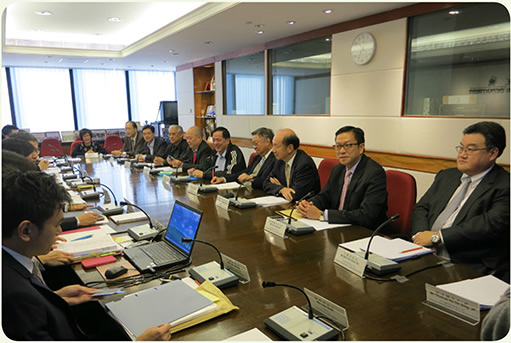Labour Advisory Board Report 2013-2014 - Chapter 2
Labour Advisory Board
2.1 Introduction
The Labour Advisory Board (LAB) is a non-statutory body appointed by the Chief Executive to advise the Commissioner for Labour on labour matters including legislation and Conventions and Recommendations of the International Labour Organisation. The Commissioner for Labour is the ex-officio chairman of LAB. LAB has 12 members, six representing employers and six representing employees.
LAB plays an important part in the formulation of labour policies and gives advice on labour legislation.
2.2 History
| 1927 |
LAB was first appointed.
|
| 1946 |
LAB became a tripartite body, with the Labour Officer as the ex-officio chairman.
|
| 1947 |
The Commissioner of Labour became the ex-officio chairman of LAB.
|
| 1950 |
LAB was reconstituted and election was introduced for the first time.
|
| 1977 |
The membership of LAB was increased by four to 12.
|
| 1985 |
The term of office of LAB was extended from one to two years.
|
| 1989 |
The number of nominated employer representatives and elected employee representatives was increased from four to five.
|
| 1993 |
LAB members were entitled to honorarium and could initiate agenda items.
|
| 2003 |
The Permanent Secretary for Economic Development and Labour (Labour) became the ex-officio chairman of LAB.
|
| 2007 |
The Commissioner for Labour became the ex-officio chairman of LAB.
|
| 2013 |
LAB members served on the Standard Working Hours Committee as ex-officio members by virtue of their LAB membership.
|
2.3 Terms of Reference
LAB advises the Commissioner for Labour on matters affecting labour, including legislation and Conventions and Recommendations of the International Labour Organisation. Where considered necessary, it may appoint committees and include any person not being a member of LAB to serve on the committees.
2.4 Composition
| Chairman: | Commissioner for Labour (ex-officio) |
| Members: |
Employer representatives
Five members nominated by major employer associations, representing separately:
One member appointed
ad personam One member appointed
ad personam
|
| Secretary: | A Senior Labour Officer of LD |
2.5 LAB Election of Employee Representatives
An election by secret ballot was held on 8 December 2012 for the registered employee unions to elect employee representatives for the 2013-2014 term of LAB. In this election, 12 candidates vied for five seats as employee representatives on LAB. Out of a total of 404 employee unions registered as electors, 362 took part in the voting.
On the employer side, the five major employer associations were invited in late 2012 to nominate representatives to sit on LAB.
The remaining two members, one representing employers and the other representing employees, were appointed by the Government ad personam.
The appointment of the 12 members was published in the Government Gazette on 28 December 2012.

Labour Advisory Board meeting
2.6 Committees of LAB
To enable LAB to better cope with the enormity of matters requiring its attention, and to allow opportunities for important stakeholders outside LAB to offer advice on individual labour issues, five committees on special subject areas have been set up under LAB. They are:
- Committee on Employees’ Compensation
- Committee on Employment Services
- Committee on the Implementation of International Labour Standards
- Committee on Labour Relations
- Committee on Occupational Safety and Health
In addition to LAB members, the above committees comprised over 30 persons including employer and employee representatives from outside LAB, academics, professionals as well as representatives from government departments, public bodies and concern groups, etc.
Details of the terms of reference, composition and work of these committees are given in their relevant chapters below. Membership lists of the committees are at Appendices I to V.